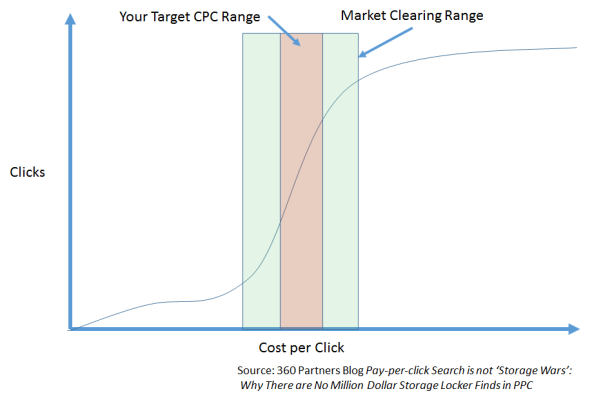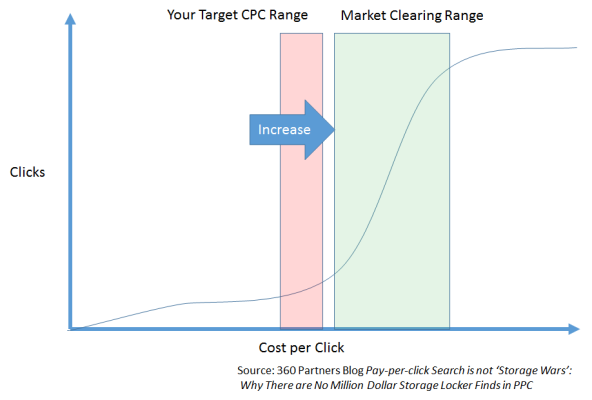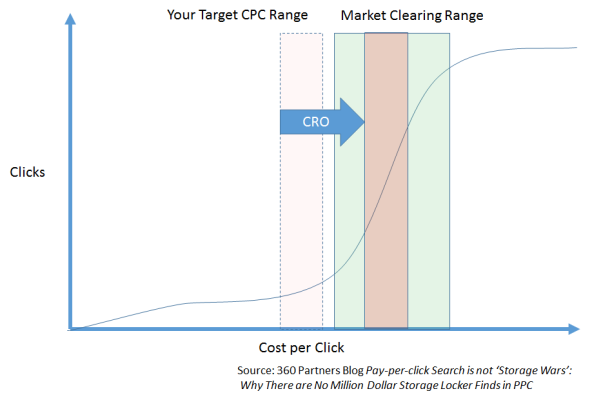How marketers should adjust to Google’s new search ad display
How will the changes to Google's ad layout affect search advertisers' strategies? Columnist Brian Massey takes a look and explains why it may be an opportunity to optimize for your mobile traffic.

This particular client was using a bid-to-position strategy and maybe enjoying a better return on the higher positions they prize. Why would this be?
Search Engine Land paid media reporter Ginny Marvin summarized the changes made to the SERPs.
To sum up the main points, there are no longer any text ads in the right sidebar of Google SERPs. The number of ads shown at the tops of these pages, in line with the natural results, increased to four from three. Three ads are shown at the bottom of the page.
Marvin notes that the number of text ads shown on these pages has dropped from as many as 11 to no more than seven. There are fewer ads, and they are in different places.
How will these new developments change the landing page optimization strategies of search advertisers? We can speculate.
Optimize your way back into the game
It seems intuitive that having fewer ads on each SERP is going to make ad positions more competitive. The effect on click prices is yet to be seen.
Google has been testing this new design for some time, and the search giant certainly benefits from higher click costs. As Marvin writes:
[blockquote] Many are predicting that fewer ads will lead to higher prices due to supply and demand. Yet it may not be that simple.[/blockquote]
Jim McKinley of search firm 360 Partners has done a study of average click costs that I think helps us wrap our heads around the effects of search ad changes. The search company calculated the clicks generated by ads at various prices for similar keywords.
They plotted this data on a graph and saw an “S” curve. While clicks go up with higher bids, there is an inflection point where smaller increases in bids yield many more clicks. They labeled this sweet spot the “Market Clearing Price” range.

The Market Clearing Price range offers the most clicks to your site.
If your target CPC (cost per click) range falls within the market clearing price range, you can expect to participate in a larger portion of the clicks from the keywords you value.

When our target CPC range falls within the Market Clearing Price range, all is well.
However, if the competition continues to fight for seven ads instead of 11, the market clearing range would be expected to shift to higher prices. If a business is only profitable paying between 30 cents and 60 cents for a click, and the market clearing price range is between $1 and $2, they cannot participate in this higher volume of clicks.

When competition for fewer ads increases prices, businesses may not be able to compete.
This has the effect of reducing competition and would be expected to prevent runaway price increases. Businesses that can’t run a profitable search ad campaign within the market clearing range just can’t bid more and must settle for what McKinley calls “Low Traffic Zone” clicks.
One solution to this problem is to increase prices or profitability of the products and services sold. Another solution is to reduce acquisition costs, allowing these businesses to profitably bid higher on these more competitive keywords. Without some response, these businesses will have to find alternative sources of qualified visitors.

Increasing the performance of the website can move us back into the high-traffic range.
If the new SERPs do result in an increase in click costs, this gives new imperative to conversion optimization programs to generate more revenue from this traffic. Increasing website conversion rates and revenue per visit can have the net effect of lowering acquisition costs.
This effectively moves the target price range higher. When the target range again overlaps the market clearing range, more abundant clicks can be had profitably.
Will bounce rates rise?
The right sidebar is the place that ads are expected — not just on SERPs, but on publisher sites, blogs and websites of all stripes. We have been trained that the right sidebar is where advertisers shill their wares. Arguably, clicks on sidebar ads are more likely to be purposeful.
However, ads that are difficult to distinguish from natural listings may be clicked on accidentally, causing more “pogo-ing.” Visitors who didn’t have buying intent may click on ads accidentally and return immediately.
Higher “pogo rates” can decrease quality scores on these ads — high-quality scores bumping ads higher on SERPs for the same bid. Optimizing landing pages is one way to decrease bounce rates and punitive pogoing.
Is mobile going to become more important?
These new SERP pages are much more similar to mobile SERPs. Ads and natural results are listed in a single column. For most of our clients, mobile traffic is one of the fastest-growing sources.
Can we begin to make up for higher competition for desktop searches by upping our game on mobile?
Don’t write off mobile
Many businesses write off mobile traffic. It converts at a much lower rate than desktop traffic. Often the website cannot deliver the same value on a small screen as on larger screens. In some cases, the sites just don’t work on iOS and Android.
Don’t settle for mobile-friendly
We aren’t ready to concede that mobile sites can’t deliver the conversions. In many cases, businesses have simply gone “mobile-friendly” using responsive web design (RWD).
RWD suffers from slow mobile performance. More importantly, you are offering small-screen mobile visitors the same content and calls to action that desktop users get.
Mobile visitors want an experience that is, well, mobile. Desktop searchers are more often in a lean-forward research mode. Tablet visitors can be found in a lean-back, legs-crossed, “entertain me” mode.
Mobile visitors are more often coming in with a quick-hit, get-it-now attitude.
Optimize for mobile searchers
It can be daunting to do a complete custom mobile version of your site. It’s not required.
Start with a mobile site similar to your desktop site and optimize your way to higher mobile performance. Here’s how we do it:
1. Slim down. Remove — don’t just hide — unnecessary images, content and features that slow load times.
2. Change your calls to action. Remove long forms, and make more use of smaller forms, one-click actions and click-to-call features.
3. Simplify navigation. Remove research-oriented tasks in favor of action-oriented tasks.
4. Use sticky elements to keep calls to action on the screen.
5. Consider alternative goals. You may have more luck collecting email addresses on mobile and using email to entice visitors.
Each of these strategies can be tested to find the optimal combination for the largest segments of your mobile visitors.
The impact of the new Google SERPs is yet to be fully understood. If things go south for your business, you can use optimization to increase your ability to bid at market-clearing prices by lowering acquisition costs and bounce rates.
Regardless of the effect on your business, there is a huge opportunity in optimizing for your mobile traffic.
Contributing authors are invited to create content for MarTech and are chosen for their expertise and contribution to the martech community. Our contributors work under the oversight of the editorial staff and contributions are checked for quality and relevance to our readers. The opinions they express are their own.
Related stories
New on MarTech